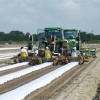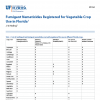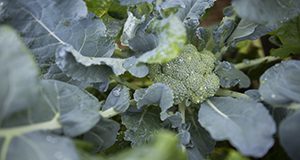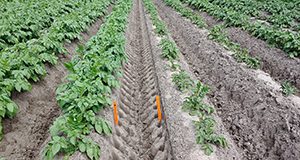Many different plant-parasitic nematodes cause yield loss in cabbage, broccoli, collards, and other valuable Florida cole crops. This 13-page fact sheet written by Z. J. Grabau and J. W. Noling and published by the UF/IFAS Entomology and Nematology Department lists common symptoms, explains how to submit samples to a nematology lab such as the UF Nematode Assay Lab for diagnosis, and describes key cultural practices to help agricultural professionals spot and manage nematode problems in cole crops.
https://edis.ifas.ufl.edu/ng024
Tag: J.W. Noling
Nematode Management in Potatoes (Irish or White)
Plant-parasitic nematodes are a major pest on potatoes in Florida. Root-knot, sting, and stubby-root nematodes are the primary problems. Sampling is an important component of confirming nematode problems in a field. Nematode management relies heavily on chemical control (nematicides), but crop rotation and soil culture are important considerations as well. This 12-page fact sheet about nematode management in potatoes was written by Zane J. Grabau and J.W. Noling and published by the UF Department of Entomology and Nematology.
http://edis.ifas.ufl.edu/ng029
Foliar or Bud Nematodes in Florida Strawberries
Foliar or bud nematodes are little-known nematodes that caused “crimp disease” in Florida strawberries in the early 1900s. Recently, these foliar nematodes have been observed again in the state, and seem to have come in with transplants from outside Florida. Foliar/bud nematodes can devastate a crop of strawberries. Plants become stunted with curled up leaves, and produce few or no flowers or fruits. This 7-page fact sheet written by J. Desaeger and J. Noling and published by the UF/IFAS Department of Entomology and Nematology provides much-needed information on these little-understood pests, summarizing the different types of foliar nematodes, their biology, life cycle, damage symptoms, survival strategies, dissemination, and management options.
edis.ifas.ufl.edu/in1184
Reducing Fumigant Application Rates and Soil Emissions with Plastic Mulch Technology (ENY046/IN403)
 With the new fumigant regulations and rising cost of crop production, including fumigants, it would be desirable to reduce the standard use rate of soil fumigants. The use of higher-barrier, gas-impermeable mulches may make it possible to reduce fumigant application rates by helping to contain the fumigant longer within the soil and reduce overall emissions into the atmosphere. The results of field studies show that fumigant application rates can be reduced by 20 to as much as 40% through the use of virtually impermeable or the more gas-tight TIF mulch films at the time of application. This 5-page fact sheet was written by J. W. Noling, and published by the UF Department of Entomology and Nematology, March 2013.
With the new fumigant regulations and rising cost of crop production, including fumigants, it would be desirable to reduce the standard use rate of soil fumigants. The use of higher-barrier, gas-impermeable mulches may make it possible to reduce fumigant application rates by helping to contain the fumigant longer within the soil and reduce overall emissions into the atmosphere. The results of field studies show that fumigant application rates can be reduced by 20 to as much as 40% through the use of virtually impermeable or the more gas-tight TIF mulch films at the time of application. This 5-page fact sheet was written by J. W. Noling, and published by the UF Department of Entomology and Nematology, March 2013.
http://edis.ifas.ufl.edu/in403
Fumigant Nematicides Registered for Vegetable Crop Use in Florida (ENY064/IN980)
 This 3-page fact sheet lists of multispectrum fumigant nematicides currently registered for use on different Florida crops (Table 1); their maximum rates and specific details for field application (Table 2); and a generalized summary of maximum use rate and relative effectiveness of various soil fumigants for nematode, soilborne disease, and weed control in Florida (Table 3). Written by J. W. Noling, and published by the UF Department of Entomology and Nematology, January 2013.
This 3-page fact sheet lists of multispectrum fumigant nematicides currently registered for use on different Florida crops (Table 1); their maximum rates and specific details for field application (Table 2); and a generalized summary of maximum use rate and relative effectiveness of various soil fumigants for nematode, soilborne disease, and weed control in Florida (Table 3). Written by J. W. Noling, and published by the UF Department of Entomology and Nematology, January 2013.
http://edis.ifas.ufl.edu/in980
Proper Calibration of Soil Fumigant Application Equipment (ENY047/IN404)
 Calibration of soil fumigant equipment and determination of soil fumigant application rate are two of the most important factors contributing to the success or failure of pest control efficacy and crop production response, yet generate some of the greatest confusion among many researchers and growers alike. This 5-page fact sheet was written by J.W. Noling, and published by the UF Department of Entomology and Nematology, December 2012.
Calibration of soil fumigant equipment and determination of soil fumigant application rate are two of the most important factors contributing to the success or failure of pest control efficacy and crop production response, yet generate some of the greatest confusion among many researchers and growers alike. This 5-page fact sheet was written by J.W. Noling, and published by the UF Department of Entomology and Nematology, December 2012.
http://edis.ifas.ufl.edu/in404
HS1166 Methyl Bromide Fumigant REDs Regulations Overview
HS1166, a 10-page fact sheet by Andrew M. MacRae and Joseph Noling, provides growers, applicators, and owner/operators with an overview of new mitigation measures and reporting requirements for methyl bromide. Published by the UF Department of Horticultural Sciences, April 2010.
http://edis.ifas.ufl.edu/hs1166
HS1167 Overview of New EPA Regulations Affecting Use of Metam Sodium and Metam Potassium
HS1167, a 10-page fact sheet by Andrew MacRae and Joseph Noling, provides a a general overview of the new mitigation measures growers and certified applicators will be required to implement, based on the new reregistration eligibility decisions (REDs) for metam sodium and metam potassium. Published by the UF Department of Horticultural Sciences, April 2010.
http://edis.ifas.ufl.edu/hs1167
HS1168 Chloropicrin Fumigant REDs Regulations Overview
HS1168, a 10-page fact sheet by Andrew MacRae and Joseph Noling, provides an overview of the new measures that will be required for fumigant applicators and growers using chloropicrin. Published by the UF Department of Horticultural Sciences, May 2010.
http://edis.ifas.ufl.edu/hs1168
HS1169 Maximizing the Efficacy of Soil Fumigant Applications for Raised Bed Plasticulture Systems of Florida
HS1169, a 5-page fact sheet by Andrew MacRae, Joseph Noling, and Crystal Snodgrass, describes several factors in crop production that should be considered to maximize the efficacy of alternatives to methyl bromide. Published by the UF Department of Horticultural Sciences, April 2010.
http://edis.ifas.ufl.edu/hs1169
HS1158 Greenhouse Nematode Management, Florida Greenhouse Vegetable Production Handbook – Vol 3
HS1158, an 8-page illustrated fact sheet by J.W. Noling and J.R. Rich, is part of the July 2009 revision of SP-48 Florida Greenhouse Vegetable Production Handbook, volume 3. It describes the practices and considerations for nematode management in greenhouse production. Published by the UF Department of Horticultural Sciences, July 2009.
http://edis.ifas.ufl.edu/HS1158


